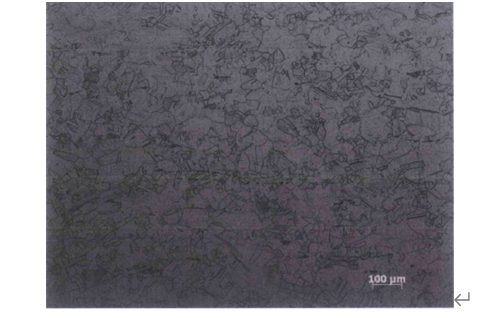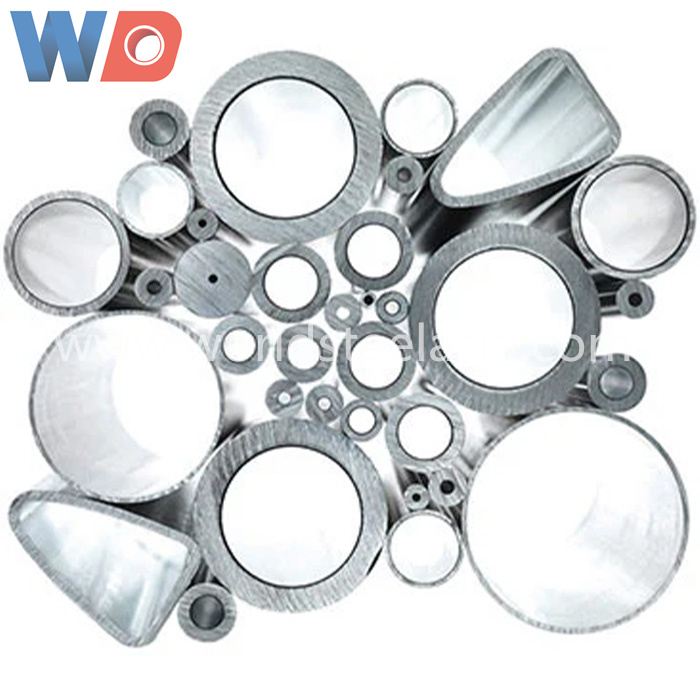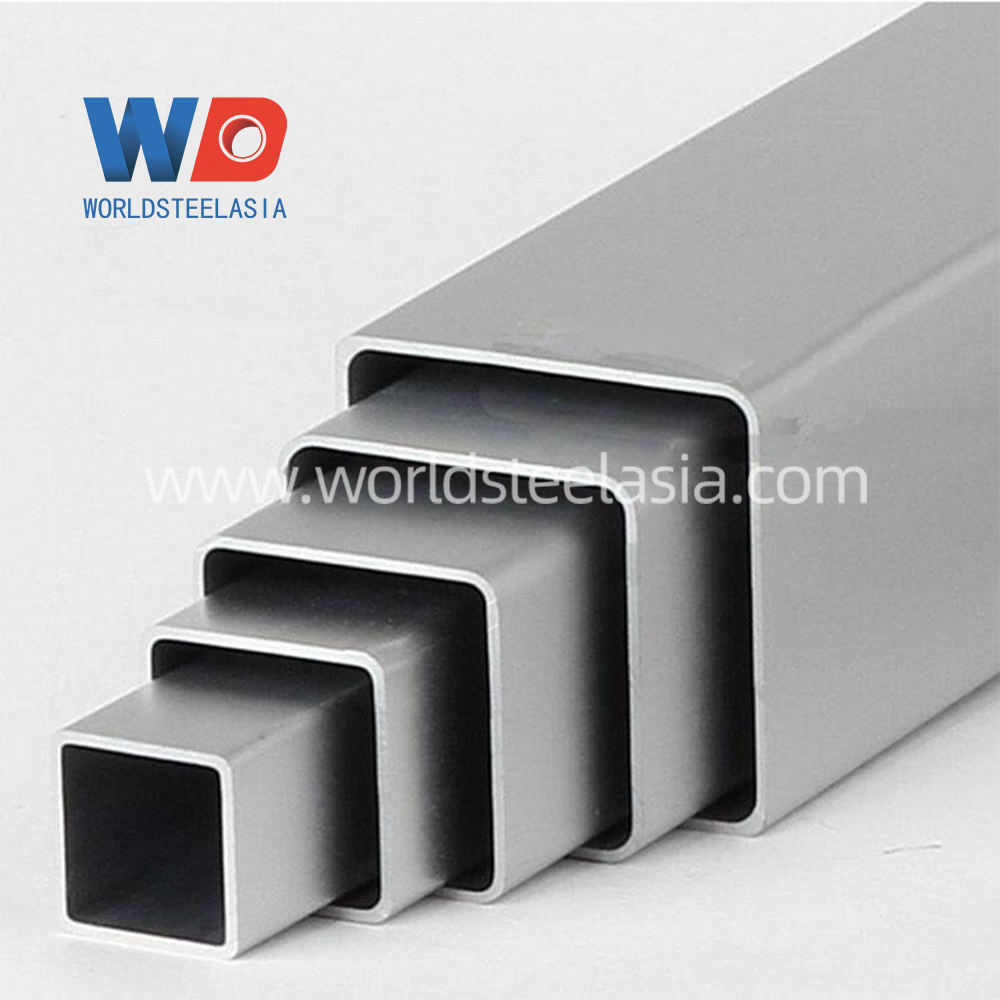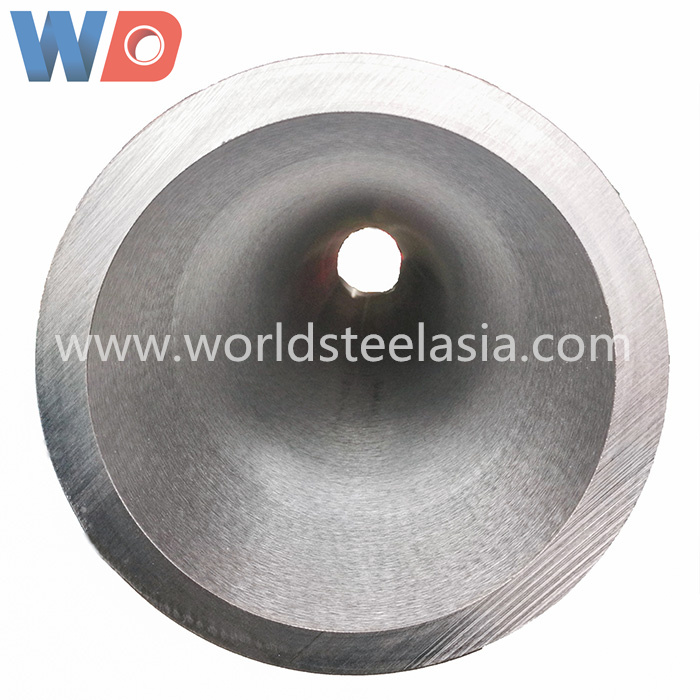TP 347 347H stainless steel seamless tube
Research and development of large diameter thick wall TP347H stainless steel seamless pipe for petrochemical hydrogenation unit
What's TP347H stainless steel seamless pipe ?
AISI : 347 TP347H
UNS : S34700 S34709
EN: 1.4912
seamless pipe , pipe fittings , flange .
The application environment and technical requirements of 347 347h en 1.4912 stainless steel seamless pipe in petrochemical hydrogenation unit, systematically studied and summarized the key technical characteristics of the production process of large-diameter thick wall stainless steel seamless pipe such as smelting and control technology, plastic forming process, hot piercing process, cold rolling pipe processing, solid solution heat treatment and their impact on product performance. UNS TP347 specification is successfully trial produced Ф 610mm × wall 59.54mm large-diameter thick wall austenitic stainless steel seamless pipe. The test results show that the technical indexes of the trial produced steel pipe meet the requirements of ASTM A312 standard and general technical conditions for steel pipe procurement, and meet the requirements of large-diameter thick wall stainless steel seamless pipe for petrochemical hydrogenation unit.
Key words: large diameter; Thick wall; Petrochemical hydrogenation; Stainless steel pipe
At present, with the transformation and development of petrochemical and coal chemical industries, in order to pursue the best economic benefits, the scale of units tends to be large-scale, large-scale, refining and chemical integration, industrial clustering and sustainable development. At present, large chemical plants such as 10 million tons of oil refining, 1 million tons of ethylene and 4 million tons of indirect coal liquefaction have become the mainstream refining and chemical equipment in the industry. The hydrocracking, residue hydrogenation, catalytic cracking, hydrofining, catalytic reforming and other hydrogenation units supporting refining and chemical industry are important measures to improve the utilization of oil resources, promote the efficient conversion of heavy oil to obtain more light oil products such as gasoline and diesel, adapt to increasingly stringent emission standards, 347h seamless stainless steel pipe, improve the environment, control haze and other pollution, promote green development and deal with global climate change. Therefore, as a particularly important reaction process in the petrochemical industry, hydrogenation process is the core link of petroleum product refining, upgrading and heavy oil processing. It can reflect the refining level and is a symbol to measure the development level of a country's petroleum and coal refining technology.
1. Application environment analysis
With the utilization of high sulfur crude oil resources and the promotion of efficient conversion of heavy (residue) oil to obtain more light oil products such as gasoline and diesel, key technologies such as heavy (residue) oil hydrotreating (RHT) technology and its combined new process with catalytic cracking (FCC) (RICP) have significantly improved the yield of light oil products. The general working temperature of the hydrogenation unit is about 400 ℃ and the pressure is 10 ~ 15MPa. The transmission medium generally includes heavy oil (residue), various catalysts, detergents, hydrogen, waste residue (sulfide, acidic water), etc. The hydrocracking unit needs to operate under the conditions of high temperature, high pressure and hydrogen (high ratio H2 (H2S), H2 + oil and gas (H2S)) corrosive medium. H +, HS - and S2 - will be ionized in the aqueous solution. The corrosion of stainless steel is a process of hydrogen depolarization. It is easy to cause hydrogen induced cracking (HIC), sulfide application corrosion cracking (SSCC) and electrochemical corrosion [6-11]; It is also accompanied by the changes of CO2, NH4 + and CN - contents, pH value and many other conditions [12-13], resulting in the rupture and failure of the pipe body. Therefore, UNS s34700 TP347H stainless steel pipe used in high temperature, high pressure and hydrogen environment needs to have good mechanical properties and corrosion resistance.
2 Technical conditions and requirements for pipes
2.1 Chemical composition
The main chemical elements affecting H2S corrosion in steel are C, Mn, P and S. C is the main element forming M23C6 phase. With the increase of content, it is easy to produce carbide segregation, resulting in the hardness deviation between the segregation area and the surrounding organization, resulting in HIC Corrosion [14]. When meeting the performance of steel pipe, control w (c) ≤ 0.08% as far as possible; S element forms MNS and FES non-metallic inclusions in steel, resulting in loose local microstructure and inducing hydrogen induced cracking (HIC) or sulfide application corrosion cracking (SSCC) in wet H2S environment. Therefore, the content of S is strictly controlled to make its w (s) ≤ 0.015%; P can reduce the austenite phase zone and form a low melting point compound with steel, so that its w (P) ≤ 0.03%; Mn and Si are the main elements to form inclusions. American Standard ASTM A312 requires w (MN) ≤ 2.0%, w (SI) ≤ 1.0%, and the actual content control is more strict. 347H stainless steel pipe made in china
2.2 Non metallic inclusions
Non metallic inclusions are easy to cause local hydrogen enrichment to form molecular hydrogen, and high hydrogen pressure rise is easy to produce cracks. Therefore, the reduction, dispersion and spheroidization of non-metallic inclusions, especially sulfide inclusions, can improve the stability of steel in H2S medium [15]. According to the standard of non-metallic inclusions in ASTM E45: sulfide ≤ grade 1.5; Silicate ≤ grade 1.5; Alumina ≤ grade 1.5; Spheroidized oxide ≤ grade 1.5; Total number of levels ≤ 5.0; There is no segregation and banded inhomogeneous structure with a size greater than grade 2.5 in E45 standard.
2.3 Dimensional deviation and appearance quality
The allowable deviation of wall thickness of 347 seamless pipe is ± 12.5%; The length of single branch shall not be less than 5.5m; The bending degree of steel pipe shall not be greater than 2mm / M; The out of roundness and uneven wall thickness of the steel pipe shall not exceed 80% of the outer diameter and wall thickness tolerances respectively. The inner and outer surfaces of the steel pipe shall be free of cracks, folds, scabs, rolling folds, delamination and other defects.
2.4 Tensile properties
347h with the increasing strength of stainless steel, the hydrogen embrittlement sensitivity increases; A large number of experimental analysis shows that the maximum hardness value of steel without SCC is between hrc20 and 27, and hrc22 is taken as the critical hardness value in engineering [16]. Carry out tensile tests at room temperature and 500 ℃, and meet the requirements of mechanical properties at room temperature and high temperature
2.5 Grain size and intergranular corrosion
The original austenite grain size shall be grade 4 ~ 7; Intergranular corrosion test is qualified.
3 Production process
There are many smelting methods of stainless steel, including EAF + VOD or AOD smelting. Wujin stainless and Yongxing new materials jointly tackle key technical problems through upstream and downstream enterprises of the industrial chain, control the chemical composition and steel purity of products, and ensure the mechanical properties of products at room temperature and high temperature; According to the process of large-diameter thick wall cold rolling pipe, ensure the dimensional accuracy, surface quality and grain size of steel pipe.
Production process flow of trial produced steel pipe: EAF → AOD refining → die cast ingot → hot forging → rolling → finishing → hot piercing → pickling → inspection and grinding → cold rolling → degreasing → solution heat treatment → finishing → pickling → finished product inspection and test → packaging → warehousing (finished product).
3.1 Smelting and control technology
In smelting, the carbon equivalent shall be controlled at a lower value, the content of P and s shall be strictly controlled, the non-metallic inclusions in steel shall be reduced and the purity of steel shall be improved. At the same time, the five low melting point harmful elements Sn, as, Sb, Bi and Pb are controlled; The key technology is ① during the initial refining of EAF electric arc furnace, the alloy composition is regulated, the O2 / AR ratio is continuously adjusted, and the oxygen content is strictly controlled while decarburizing [17]; ② AOD refining adopts double slag process and reasonable slag ratio to improve the ability of slag to absorb floating inclusions; Proper argon blowing process at the bottom of the furnace can fully float the inclusions in the molten steel, greatly improve the purity of molten steel and reduce the sensitivity of hydrogen induced cracking of steel.
3.2 Plastic forming technology
The heating system of forging and hot rolling is established: the billet temperature rises slowly in the heating process to improve the consistency between the billet surface and the central temperature. When forging, consider the temperature drop, deformation mode and heating times, especially the final forging temperature ≥ 950 ℃, so as to avoid incomplete recrystallization caused by too low temperature, resulting in the formation of mixed grain structure with uneven grain size; In the forging process, control the heating temperature and deformation, break the columnar crystal on the ingot surface, and the forging compression ratio is ≥ 3, so as to obtain uniform grain structure.
3.3 Hot piercing process
Due to the pinning effect of precipitated NBC on grain boundary and dislocation movement during thermal perforation, it hinders the movement of dislocation and grain boundary in the crystal, resulting in precipitation strengthening, and the deformation resistance is relatively large [18]. Adjusting and optimizing the heating system of round steel reveals the interaction and correlation law between the perforation temperature evolution of large-diameter thick wall stainless steel in large rolling angle cross rolling and metal streamline, interface state and multiple factors, adjusting and optimizing the parameters such as heating system, hot perforation speed and thermal deformation, and mastering the defect generation mechanism and regulation method in the hot perforation process of large-diameter stainless steel [19-21], so as to solve the problems of internal crack, skin warping Quality problems such as delamination and surface cracking.
3.4 Solution heat treatment process
The wet H2S corrosion environment of high-pressure hydrogenation unit has strict requirements on the strength, hardness, microstructure, grain size and intergranular corrosion of large-diameter stainless steel seamless pipe. As a key process to ensure the microstructure and properties of finished pipes, solution heat treatment not only eliminates the cold working stress, but also directly affects the strength, corrosion resistance, microstructure and other comprehensive properties of pipes [22-23]. During solution heat treatment, according to the characteristics of large-diameter stainless steel seamless pipe, extend the heating time and sufficient holding time to make the carbides fully re dissolve and remain in the austenite structure at room temperature, promote the uniform distribution of elements and obtain low intergranular corrosion sensitivity. The heat treatment temperature of TP347 is controlled at 1150 ~ 1190 ℃, the flow and rate of cooling water are increased, and the high-temperature pipe is cooled quickly through the sensitization range to avoid the tendency of intergranular corrosion and meet the comprehensive performance requirements of the pipe.
4 performance test results
UNS S34700 ; UNS S34709 ; TP347 stainless steel seamless pipe shall be inspected according to the chemical composition, mechanical properties, dimensional tolerance, grain size, ultrasonic and hydraulic nondestructive testing of finished products in American Standard ASTM A312 / a312m-17 and relevant technical agreements.
4.1 Chemical composition of 347h
The finished chemical composition of TP347 / TP347H stainless steel seamless pipe meets the requirements of American Standard ASTM A312 / a312m-17
4.2 Non metallic inclusions
The purity of materials is related to the corrosion resistance of materials in use. According to ASTM e45-10 Standard Test Method for determination of inclusion content in steel, samples are taken at the end of the test material, and the level of non-metallic inclusions meets the standard requirements
4.3 Intergranular corrosion performance
According to method E in ASTM a262-14 determination of intergranular corrosion sensitivity of austenitic stainless steel, no intergranular corrosion cracks are found on the inner and outer surfaces of the sample, as shown in Figure 1. The intergranular corrosion performance of TP347 stainless steel seamless pipe is qualified.

4.4 Grain size
The grain size is determined according to ASTM e112-2013 test method for determination of average grain size. The grain size is grade 5.5, which meets the requirements of grade 4 ~ 7 in the standard, as shown in Figure 2.

4.5 Flattening performance
According to the requirements of ASTM a530-2010 General requirements for special carbon steel and alloy steel pipe, the test is carried out on the electro-hydraulic servo universal material testing machine we-600c, and there are no visible cracks on the inner and outer surfaces and end faces, meeting the requirements of astma312 / a312m-17 standard and general technical conditions for steel pipe procurement
4.6 Hydrostatic test, ultrasonic flaw detection and penetrant flaw detection
Tested on syd-610 (0-35 MPa) hydrostatic testing machine according to ASTM a999 standard and general technical conditions for steel pipe procurement, meeting the requirements; NDT was carried out on ctb-1000 ultrasonic flaw detector according to ASTM A312 / a312m-17 standard and general technical conditions for steel pipe procurement, which met the requirements; Penetrant flaw detection shall be carried out on the groove of steel pipe according to ASTM e165 method B and general technical conditions for steel pipe procurement. The standard requires testing on the outer surface and groove of the pipe, which meets the requirements.

ASTM A213 ASME SA213M Standard for 347H Seamless Austenitic Alloy-Steel Boiler, Superheater
Heat exchanger seamless tube , 347H stainless steel pipe factory
FROM WORLDSTEELASIA
Any inquiry please send to : CHONGQING WORLD STEEL CO., LTD
Https: www.worldsteelasia.com



